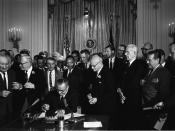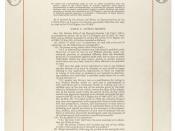This paper will go over the history of a few important acts that have been passed over the years to protect employees in the United States. This paper will also discuss the major protections that these acts provide, and who are eligible for that protection, as well as some of the differences between an independent contractor and an employee. Lastly, this paper will discuss what the necessary steps are for a worker to obtain protection under one of the acts.
The Civil Rights Act enacted in 1964 (Title VII) was initiated to prohibit employment discrimination regardless of race, color, religion, sex, or national origin. In the early 1990s, employment discrimination legislation passed two major acts. The 1991 Americans with Disabilities Act and Civil Rights Act. These amendments were to strengthen, as well as, improve Federal civil rights laws. The acts help to provide damages in cases of intentional employment discrimination, and to clarify provisions regarding disparate impact actions.
(The U.S. Equal Employment Opportunity Commission, 1997)The Pregnancy Discrimination Act was put into place in 1978 as an amendment to title VII. "This amendment forbids employment discrimination because of pregnancy, childbirth, or related medical conditions. Thus, a work rule that prohibits the hiring of pregnant women violates Title VII." (Cheeseman, 2007).
The Americans with Disabilities Act was signed into law on July 26, 1990 and is the largest civil rights legislation since the Civil Rights Act of 1964. Cheesman states that, "The ADA imposes obligations on employers and providers of public transportation, telecommunications, and public accommodations to accommodate individuals with disabilities" (2007).
The Age Discrimination in Employment Act was enacted in 1967. "Primarily, employers have often refused to hire older workers. The Age Discrimination in Employment Act (ADEA) prohibits certain age discrimination practices" (Cheesman, 2007). At the time, some employers would use...


